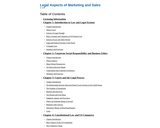
Short Description:
This book is aimed at managers, business owners, marketing managers, and aspiring social media marketing interns and managers. I will assume that however accomplished in your own field - baker, developer, teacher and that even as successful business owners, you approach the topic of social media marketing as a beginner. Even if you are an avid personal user of social networks, we will treat this book as a guided tour of social media for marketing purposes.
Long Description:
This book is aimed at managers, business owners, marketing managers, and aspiring social media marketing interns and managers. I will assume that however accomplished in your own field – baker, developer, teacher and that even as successful business owners, you approach the topic of social media marketing as a beginner. Even if you are an avid personal user of social networks, we will treat this book as a guided tour of social media for marketing purposes.
While this is a textbook, it is not meant to read like a traditional textbook, especially on a topic that is rooted in digital to an audience who, let’s be honest, doesn’t really like to read. No shade. I too would rather watch a YouTube video on how to fix a problem with my laptop than read the manual.
Like many of my Generation X peers, I began using forums and chat rooms in the early 1990’s and have watched social networks come and go (AOL and Yahoo chat rooms, Friendster, Myspace) – To those not inclined to spend countless hours online over the past couple of decades, it may seem as if things change too often.
For others, particularly those born into the technology, aka digital natives, social networks as with most technology, are second nature to you, but not having work experience may leave you perplexed as to what your boss/ client / customers really want from you as a social media manager.
If you fall within either one of these audiences, this book is for you. I will do my best to help you sort out a basic understanding of the why of social media as a marketing tool for business, for personal brand building, and perhaps more importantly, where to find supporting information and research to help you design, monitor, test, and re-define a social media marketing strategy.
If you are utilizing this book as an instructor or are considering using this book as an instructor, first of all, Thank you very much! Here, you will find the instruction plan and a practical way of teaching students how the principles of marketing work. We will also explore the principles for each prominent social website. Also, the exercises with every chapter will give students a better chance at understanding these concepts as well.
To sum it up, the target audience for the book is a person who is interested in social media marketing for brand building.
Word Count: 23734
(Note: This resource's metadata has been created automatically by reformatting and/or combining the information that the author initially provided as part of a bulk import process.)
- Subject:
- Business and Communication
- Communication
- Education
- Higher Education
- Marketing
- Social Science
- Sociology
- Material Type:
- Textbook
- Provider:
- Oklahoma State University
- Author:
- Cheryl Lawson
- Date Added:
- 06/23/2022









